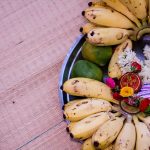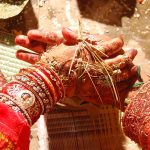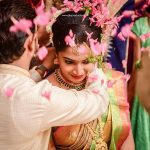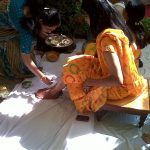Mudaliars are a community that hails from the South of India. They have moved and settled around the world but hold their traditional Tamil Mudaliar wedding traditions dear. There are variations among the sub-divisions of the Mudaliar community but the common and important ones are listed here.
Is your love a true match for marriage? Check with our Thirumana Porutham Calculator!
Nichiyathartham or the Engagement
It is generally the groom’s family that will visit the prospective bride’s home. If the groom likes the bride the families have an engagement or Nichiyathartham. The families agree on a suitable date for the wedding and a Nichyathartham Lagna Pathrikkai is signed by the parents of the bride and groom. The groom’s family gifts 21 plates laden with gifts and auspicious items such as coconuts, fruits, flowers, sugar, betel leaves, and nuts to the bride’s family. The bride’s family may also mention the gifts of jewels, property, vehicle, or house that the bride will be carrying to her marital home.
The bride’s family presents the signed Pathrikkai on a plate with gifts to the groom’s family. This is the Thambulam Mathruthal and signifies the confirmation of the engagement. Both the families start all the wedding preparations after this.

Pandakkal
The families worship Lord Ganesh in the Pillayar Pujai and invoke his blessings for the marriage. They also erect a Kalyana Pandhal which is a four-legged structure in front of the house to signify that the wedding rituals have begun. Nine Sumangalis (older married women living with their husbands) decorate the pillars of the Pandhal with Kumkum and Majal (turmeric). They place nine vessels with different pulses soaked in water and cover them. The vessels are tuned upside down till the seeds germinate. After a few days, the vessels are turned upright again and the sprouts are cared for till the wedding date.
Nalangu
The Nalungu is a ceremony that is attended by the women from the families of the bride and the groom. The bride sits on a wooden board covered with a banana leaf and uncooked rice. The married women smear the bride with sandalwood paste and place a dot of vermilion on her forehead. They sprinkle rose water on her and then perform Arthi for the bride.
Maapilai Azhaippu
The Maapillai Azhaippu is the welcoming of the groom by the bride’s uncle or brother. The groom is taken to the wedding mandap, garlanded, and then led inside with the playing of musical instruments. The women in the bride’s family welcome the groom with Arthi. There may be a simple Nalungu for the groom and the bride separately before the marriage.
Mangala Snaanam
The families of the bride and groom erect and decorate a structure called the Pandaal or Pandakal with four bamboo sticks in front of the wedding hall. It is beautified using banana tree stalks, tender coconut, mango leaves, and flowers. The bride and the groom reach this Pandal separately before sunrise on the wedding day before the Tamil Mudaliar wedding rituals. The leaders from both families apply a mixture of sesame oil and green gram flour on their forehead and turmeric on their hands. They are then made to have an oil bath. The clothes that were worn by the bride and the groom are given away to the washerman or woman.
Arasan Kal
This is a ceremony that worships the fig tree (Arasu) and the king or ruler. A bamboo stick is erected in front of the wedding hall. Five Sumangalis worship the fig tree and then clean the bamboo stick with milk. They smear it with sandalwood paste and vermilion. A cloth is tied to the stick and Arati is performed for the stick. This tradition hails back to the days when the King would attend the marriage and bless the couple.
Paadapuja And Mahalakshmi Puja
The groom washes the feet of his parents and requests their blessings. The bride also washes the feet of her parents and asks for their blessings. The Mangalyam is considered to be the form of Goddess Lakshmi and the bride performs Mahalakshmi Puja to the Mangalayam.
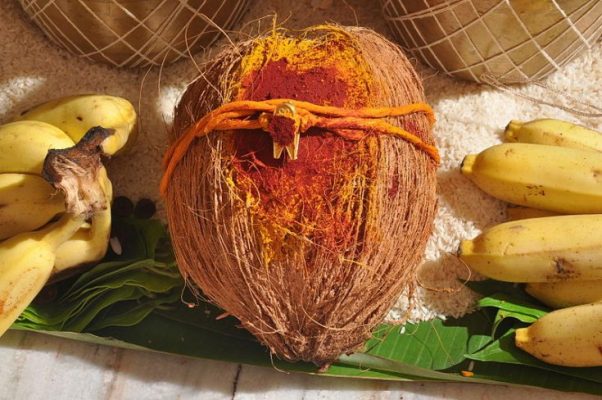
Kasi Yatra
Is your relationship a match for marriage? Check Vedic Astrology Match with our Thirumana Porutham Calculator!
This is a custom when the groom pretends that he does not want to enter married life and wants to go to Kashi as a Sanyasi. He grabs a Visri (fan), umbrella, and slippers and pretends to leave for Kashi. The bride’s father or brother then stops him and convinces him to stay and marry the bride. He will then reluctantly return to the marriage hall and be greeted again with an Arthi.
Ganapathi Homam
The bride and the groom respectively dress in their wedding clothing, wear garlands and make their way to the Pandal. The priest performs a Ganapathi Homam and then ties the sacred thread for the groom in an Upanayanam ceremony.

Manai Pongal
Before the Tamil Mudaliar wedding rituals begin, the parents of the couple cook rice in five or seven pots and offer them to the deities who are symbolically attending and blessing the couple.
Kanganam
The bride ties a yellow thread called the Kanganam to the groom’s wrist giving him the right to touch her. He also ties a Kanganam for the bride.
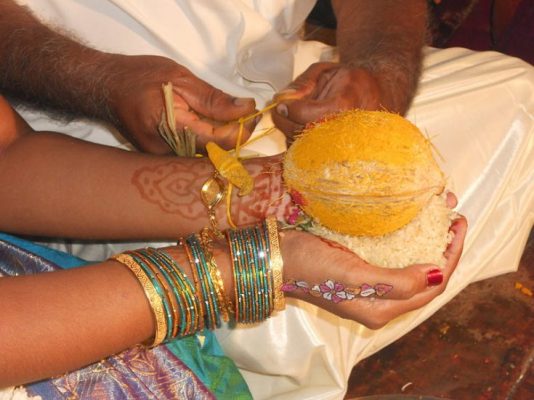
Kanikadhanam
The father of the bride agrees to give his daughter in marriage with the chanting of Vedic hymns. The bride holds a coconut and her hand is placed in the hands of the groom.
Tamil Mudaliar Wedding Rituals – Mangalya Dharanam
The tying of the Mangalyam is the most important part of the Tamil Mudaliar wedding rituals. The Mangalyam is strung on a thread of 108 strands dipped in turmeric. The Mangalyam is shaped like the tooth of a tiger. In the olden days, it would actually contain a tiger tooth taken from a tiger killed by the groom. The Mangalayam is tied at the precise Shubh Muhurtam determined by the priest accompanied by the Mangala Vadhyam music. The elders present shower the couple with Akshat (turmeric-coated raw rice) and bless them.
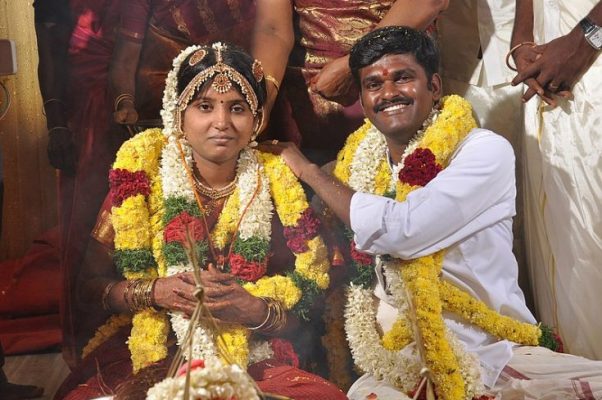
Check your marriage compatibility with your partner. Based on Vedic Astrology.
Try our Tamil Jathaka Porutham Calculator!
Pattam
The couple exchange garlands three times and a piece of gold or Pattam is tied on their foreheads.
Laaja Homam
Agni is the fire God and he stands witness to the marriage (Agni Saakshi), so the bride and groom circumambulate the Homam fire thrice. The bride’s brother places puffed rice in the hands of the bride and groom which they pour into the Homam fire. The priest directs the couple to look at the sky in the direction of the Arundhati star which is the home of Arundhati, the Goddess of morals and chastity.
Sesha
A white cloth is spread before the newlywed couple and raw rice is kept on it. The elders present bless the couple while holding the rice and place a handful in front of the couple.
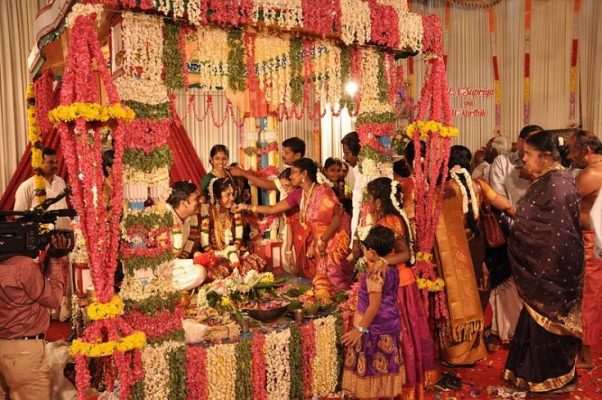
Sammandhi Mariyathai
The families of both the bride and the groom exchange clothes and gifts as a gesture of bonding and goodwill after the Tamil Mudaliar wedding rituals.
Grihapravesham
The groom’s family welcomes the bride and groom into their new home with Arthi. Lunch is served for all present.
Reception
A wedding reception with a grand dinner is held to celebrate the wedding.




